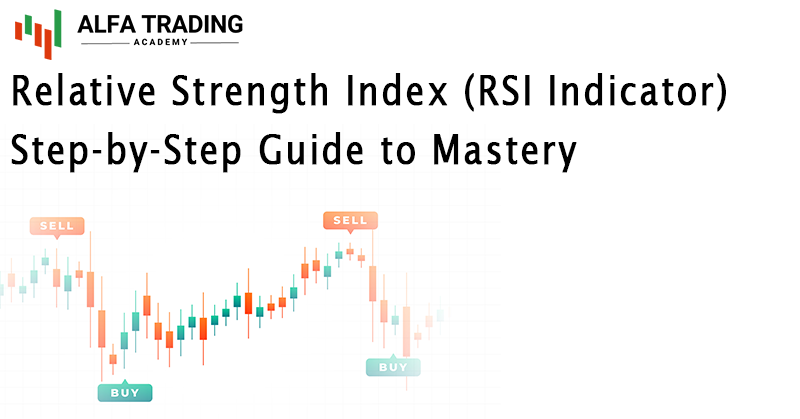Introduction to the Relative Strength Index / RSI Indicator:
The Relative Strength Index (RSI) is a momentum oscillator developed by J. Welles Wilder in 1978. This oscillator assesses the strength of price movement in an asset, represented by a single line fluctuating between 0 and 100. Usually, prices above 70 are considered overbought, and prices below 30 are considered oversold.

Calculation of the Relative Strength Index / RSI Indicator:
The RSI is calculated using the following formula:
RSI = 100 – (100 / (1 + RS))
Where: RS = Average Gain / Average Loss
To calculate the RS, you’ll need to take the average of the gains during the specified period (usually 14 periods) and divide it by the average of the losses during the same period. Once you have the RS, plug it into the RSI formula to get the final RSI value.
let’s calculate the RSI (Relative Strength Index) using an example step-by-step. For this example, let’s consider a stock’s closing prices for the last 10 days.
Closing prices (in chronological order):
Day 1: $50
Day 2: $52
Day 3: $55
Day 4: $58
Day 5: $56
Day 6: $54
Day 7: $53
Day 8: $52
Day 9: $50
Day 10: $48
Step 1: Determine the Period For this example, we will use a 10-day period for calculating the RSI.
Step 2: Calculate Price Changes Calculate the price changes (gains or losses) for each day compared to the previous day’s closing price.
Day 1: $50 – $50 = $0 (No gain or loss on the first day)
Day 2: $52 – $50 = $2 (Gain of $2 on the second day)
Day 3: $55 – $52 = $3 (Gain of $3 on the third day)
Day 4: $58 – $55 = $3 (Gain of $3 on the fourth day)
Day 5: $56 – $58 = -$2 (Loss of $2 on the fifth day)
Day 6: $54 – $56 = -$2 (Loss of $2 on the sixth day)
Day 7: $53 – $54 = -$1 (Loss of $1 on the seventh day)
Day 8: $52 – $53 = -$1 (Loss of $1 on the eighth day)
Day 9: $50 – $52 = -$2 (Loss of $2 on the ninth day)
Day 10: $48 – $50 = -$2 (Loss of $2 on the tenth day)
Step 3: Calculate Average Gain and Average Loss Now, we calculate the average gain and average loss over the 10-day period.
Average Gain = (2 + 3 + 3) / 3 = 2.67 Average Loss = (2 + 2 + 1 + 1 + 2 + 2 + 2 + 2) / 8 = 1.75
Step 4: Calculate Relative Strength (RS) Next, we calculate the Relative Strength (RS) by dividing the average gain by the average loss.
RS = 2.67 / 1.75 ≈ 1.52
Step 5: Calculate RSI Finally, we use the RS value to calculate the RSI using the formula:
RSI = 100 – (100 / (1 + RS))
RSI = 100 – (100 / (1 + 1.52)) ≈ 60.32
So, the RSI for this example, using a 10-day period, is approximately 60.32. This RSI value indicates a neutral zone, neither overbought nor oversold, suggesting the stock is experiencing moderate price momentum.
Interpreting Values of the RSI Indicator:
The RSI indicator oscillates between 0 and 100, with levels above 70 considered overbought, and levels below 30 considered oversold. An RSI above 70 indicates that the asset may be overvalued and could experience a price correction or pullback in the future. Conversely, an RSI below 30 suggests that the asset may be undervalued and could potentially experience an uptrend in the future.

Identifying Divergence with the RSI Indicator:
One of the most powerful ways to use the RSI is to spot divergence. Divergence occurs when the price trend and the RSI indicator move in opposite directions.
- Bullish Divergence: Bullish divergence occurs when the price of an asset forms a lower low, but the RSI indicator forms a higher low. This indicates that the momentum of the price downtrend is weakening, and a potential bullish reversal. It suggests that despite lower prices, the RSI shows increasing strength, implying that the downtrend may soon come to an end.

- Bearish Divergence: Bearish divergence occurs when the price of an asset forms a higher high, but the RSI indicator forms a lower high. This indicates that the momentum of the price uptrend is weakening, and a potential bearish reversal. It suggests that despite higher prices, the RSI shows decreasing strength, implying that the uptrend may be losing steam.

- Bullish Hidden Divergence: Bullish hidden divergence occurs when the price chart of an asset forms a higher low, while the oscillator forms a lower low. This indicates that even though the price is showing a temporary pullback or correction in an ongoing uptrend,the uptrend is likely to continue after the pullback.

- Bearish Hidden Divergence: Bearish hidden divergence occurs when the price chart of an asset forms a lower high, but the oscillator forms a higher high. This indicates that despite the price showing a temporary bounce or correction in an ongoing downtrend, the downtrend is likely to continue after the bounce.

Using RSI indicator as a Confirmation Tool:
The RSI is an excellent confirmation tool when used alongside other technical indicators and chart patterns. For instance, if you observe a bullish breakout from a chart pattern, confirming the move with a rising RSI above 50 can strengthen your confidence in the upward trend. Similarly, a bearish breakout accompanied by a declining RSI below 50 can validate a downward trend.
Using Rate of RSI Indicator with Tradingview:
Goto Indicators, then search for “Relative Strength Index .” Click on the name of indicator to insert it into chart

Using RSI Indicator with MetaTrader 5 (MT5):
Open Meta Trader. Then Insert > Indicators > Oscillators > Relative Strength Index

Conclusion:
The Relative Strength Index (RSI) is a valuable technical indicator that can enhance your trading and investment decisions. By understanding how to calculate and interpret RSI values, identifying divergence, and using it alongside other tools, you can gain a comprehensive mastery of this powerful tool. Remember that like any indicator, the RSI works best when combined with other forms of analysis and risk management strategies.
Explore Our Algorithmic Trading Courses:

Cryptocurrency Investing with Python | Earn Passive Income !
Code your own Bot with Python to Automate Crypto Investing in Binance. Upload Him to a Server and He Will Do the Rest !
4.9 Rating
2.5 Hours
1.5K+
$119.99
$13.99

Binance Futures Trading with Python | Build a Market Maker Bot
Unlock the power of automated trading with Binance Futures and Python. Maximize profits with tech & expertise in trading
4.9 Rating
2.5 Hours
1.2K+
$119.99
$13.99

Forex Algorithmic Trading with Python : Build a Grid Bot
Create your own profitable Grid Bot with Python. He can trade many currency pairs at once. With free Bot included !!
4.9 Rating
3 Hours
1.5K+
$119.99
$13.99

Master Forex News Trading with Python | The Secret Strategy
Build an Automated Trading Bot to Capture the Volatility of News Events-with Semi Intelligent Take Profit and Stop Loss
4.9 Rating
2.5 Hours
1.2K+
$119.99
$13.99

Binance Futures Trading with Python | Build a Martingale Bot
Stop wasting time on Paid trading Bots – Create your own Binance Futures Bot and take control of your trading strategy !
4.9 Rating
2.5 Hours
1.5K+
$119.99
$13.99

The Complete Foundation Binance Algorithmic Trading Course
Binance Algorithmic Trading from A-Z | Spot and Futures trading, Build Strategies, Automate with Cloud Server + More
4.9 Rating
4 Hours
1.5K+
$119.99
$13.99

Forex Algorithmic Trading with Python : Build a DCA Bot
Create your own profitable DCA Bot with Python. He can trade many currency pairs at once. With free Bot included !!
4.9 Rating
3 Hours
1.5K+
$119.99
$13.99

The Ultimate Forex Algorithmic Trading Course | Build 5 Bots
Build your own SMA Crossover Bot, Bollinger Bands Trading Bot , Grid Bot, DCA Bot and a Basic Bot to learn Fundamentals
4.9 Rating
4 Hours
1.5K+





